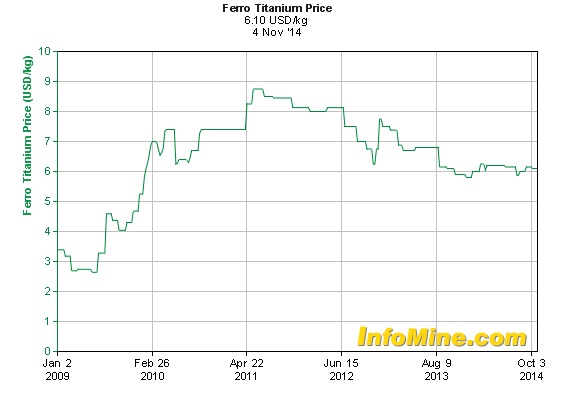Why use Titanium for construction of compression springs?
It’s quite simple: the properties of Titanium alloys are such that it makes the spring able to last longer, see a reduction in natural frequency and a 30-55% lower weight, depending on the application.
Why are Titanium products so expensive relative to similar components made of other metal alloys?
Titanium is very expensive because it requires expenses to extract from its ores – for example, from rutile, TiO2. Titanium can’t be extracted by reducing the ore using carbon as a cheap reducing agent. Titanium is extracted using chlorine and magnesium as an agent, thus adding to cost of processing. Since Titanium is more scare than other metals in the earth’s crust, it is also more costly to extract and amass a large quantity.
Additionally, the market price of titanium has increase significantly in price over the last 5 years, by approximately 90%:
 What is the basic cost ratio between Ti and steel material?
What is the basic cost ratio between Ti and steel material?
The cost ratio of Beta-Pro Titanium vs. Chrome Silicon Steel is roughly 65 to one.
What kind of wire is used for MTB coil springs?
Typically, most of the steel springs on the market will be made out of chrome-silicon or a derivative of chrome-silicon steel. Obtainium exclusively makes springs out of aerospace quality Beta-C Titanium and Beta-pro Titanium. We have a proprietary blend of allows very similar to Beta-C except it is made up of more refined alloy mix, this is our proprietary alloy: Beta-pro. We also use a grade 6-4 titanium in some application where cost is a factor.
Is there an average weight advantage for Titanium vs steel springs?
Thanks to Obtainium’s Beta-pro Titanium alloy’s low modulus, low density and high elasticity, typical weight savings will be between 30% and 55% over steel springs. The performance advantages of titanium springs extend beyond the weight savings. Data recovery systems have shown that titanium springs enhance shock performance and wheel control through improved dynamic response and lowering of the likelihood of the spring reaching natural frequency. This is a result of the reduced mass of the titanium spring. Lower mass springs develop less inertia as the suspension is displaced. Less inertia in the spring mass enables the suspension to respond quicker, resulting in improved ground contact and traction.
What is the process for making a titanium coil spring?
The actual coiling is done with a custom CNC mandrel coiler. From there, the ends are ground flat and parallel to each other. The springs are then heat-treated and sent out for shot peen. This is the process of increasing the elasticity of the coil by compressing the metal by blasting thousands of beads of metal at it.
When they return, we press them to solid to eliminate the possibility of them getting shorter under normal use. All springs are then individually inspected for proper dimensions, deflection and each is tested for proper spring rate.
Does the material in the spring need any heat treatment?
Yes, the aging and stress relieving process is very specific for titanium springs. Both duration and accurate temperature control are crucial parameters to the heat treating process.
Why do springs with softer rates often have thinner wire diameter than those springs with stiffer rates?
The three parameters that determine spring rate are:
- WIRE DIAMETER
- SPRING DIAMETER
- NUMBER OF COILS
Adjusting any one of these three parameters in a design will change the spring rate. All Obtainium Ti springs utilize an optimized spring design where we design with the smallest wire diameter and fewest coils within the maximum durability tolerances of the material. In all Obtainium springs designs we use what’s called an optimized design. This means that we design the smallest, lightest spring based on the critical dimensions (inside diameter, spring travel, and spring rate). Optimized designs reduce weight and help to keep costs down as they minimize the amount of material used. Each spring is individually inspected.
Do titanium springs have a different fatigue life versus steel springs?
Properly designed titanium springs have more resistance to set or ‘setting out’ and a longer fatigue life than highly stressed steel springs commonly used in suspension applications. When a spring has exceeded its fatigue life, it may break, but most of the time it will just ‘take set’ or get shorter. If you find yourself having to add rounds of preload to your spring to
maintain sag height, it may be time for a new spring.
Where are your products made?
They are designed and tested in the Great White Pacific Northwest, BC, Canada. Depending on the grade involved, this is sourced either from the southern USA or from the heart of Japan’s titanium capital.
How can I get updates on new products?
Shipping?
Where are Cervélo Bicycles made?
Yes, they are made in Canada. Just outside Toronto actually.
What did that last question have to do with the FAQ?
Nothing, thanks for reading this far!
 What is the basic cost ratio between Ti and steel material?
What is the basic cost ratio between Ti and steel material?